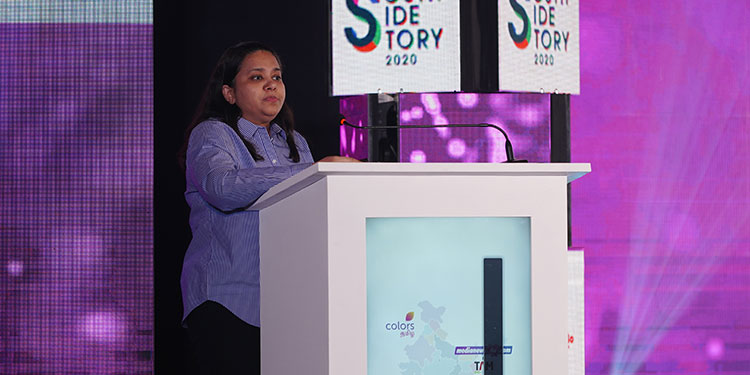Chennai: At the launch of The South Side Story 2020 and MediaNews4U “Game Changers 2019” in Chennai on 4th March’20, Vinita Shah, VP TAM Axis, addressed the audience on the Media Landscape of South India. The stage was already set through an enthralling keynote by LV Krishnan, CEO TAM Media Research.
Giving a perspective and highlighting the key insights from the Southside Story 2020, Vinita discussed the overall media landscape of South in the last decade and suggestive actions that traditional media could fuse in to overcome the future disruption.
Vinita conveyed to the audience that, the last decade in the South of India was a phase of Disruption & Transformation due to the wave called Digital. The effect of Digital has been felt on Traditional Media especially in the later part of the decade. As per TAM AdEx, the ad Volumes in South have shown growth on TV Channels by 2.5 times,6 times in Publications and 1.7 times on Radio Station as against the growth in media outlets for TV Channels by 1.5 times, more than 40% of Publications and 1.2 times of Radio Station in last decade.
While speaking on the potential that South brings to the Indian media landscape based on the TAM AdEx analysis of advertising by the traditional media, Vinita compared the decade picture of South vs. All India, which has grown for All India for TV only and a similar pattern is observed for South. The heartening news is that South India had an upper hand on Television medium in terms of ad volume growth since ad volumes for South have higher % share i.e. 2.5 times as against 1.7 times for All India.
Reflecting from the ad volumes of last decade, it shows that Southern India contributes more than 1/4th of the total ad volumes across traditional medium and establishes that Southern India is a primary contributor in terms of ad volume across traditional medium.
While focusing on The Disruption, Vinita added that disruption has been felt on traditional media is last 5 years. Explaining this further, she explained that as compared to 2.5 times growth in last decade for the south, the ad volume growth has dampened to only 40% ad volume in the last 5 years on TV medium. Additionally, at an all India level, the Print and Radio medium which had observed 60% and 1.7 times ad volume growth in the last decade, has witnessed 5% and 9% drop in the last 5 years. A similar picture emerged in southern states for last 5 yrs across traditional media.
Sharing some of the interesting finds while creating the Southside storybooks, Vinita added that the Top 10 sectors on TV, Print and Radio contribute more than 80% of the overall advertising share of South market. The Top 3 sectors that were common across all the 3 mediums were ‘Services’,’Personal Accessories’ and ‘Auto’ for last 5 years.
There were some grim news, which showed that certain categories were dropping off the Radar in Y 2019.The drop was ranging 60-80% and the category that fell in this range were Cellular Phone (Services + Smart Phones) [All Media], E-com –Online Shopping/service [Print and Radio], Breakfast /Cereals and Aerated Soft Drink, Certain categories from FMCG, Edible Oil and Life Insurance on [TV, Print and Radio] respectively. These categories have growing ad spends on the digital medium.
There was a sign of relief that the advertising in Southern India by regional players has seen a rise on TV, Print and Radio in last 5 years. Ads with Festive theme have grown in south by more than 20% compare to All India that witnessed only 7% growth. This indicates that South will continue playing a pivotal role in the Indian Media Landscape.
The last part of the presentation was the highlight of the day and these insights were for the industry as a whole to discuss for the future.
For TV medium, Vinita said, TV mainly uses the upper funnel (brand awareness, reach, etc) and to some extent the ‘lower funnel’ that measures capabilities. Digital is able to measure the lower funnel effect (purchase intent, brand consideration, etc) and help ad campaigns to be more targeted. As an action, TV will need to use more granular data and analytics. She added that layering demographic data with granular tuning data from the settop box, integration from other data, automatic content recognition, etc. is the future. Since both TV and Digital are converging, the measurement matrices should be similar and comparable, hence using lower funnel measurement in TV will be crucial.
For Print medium, the reality check is that Newspapers are fighting a lonely battle and adding to their woes news content is available and cheap plus all kind of content is called ‘news’. There are some ideas that can help the Print medium,
- Appealing layouts to keep readers interest
- Online content not to be just a copy of the offline publication,
- Build a community of readers for both online and offline outlet (increase in interaction with the reader) etc.
On Radio, the reality is that it has high local and language reach due to audience interaction and digital platform complements as App-based audio platforms are well established. Now it’s time for some action on this source by Maximizing effectiveness of brand campaigns by engaging target audiences via RJ based content, etc and build emotional engagement. This can also bring about moving the content loyal listeners of radio to sponsored podcasts.
Vinita summed up her presentation by calling out to the entire southern media industry to converge, build alliance and integrate measurement tools, so that it can continue playing a pivotal role in the India media landscape.

















